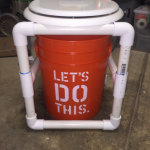Basic Introduction to Archery: Gear, Aiming and Shooting
Getting proficient with a bow and arrow starts with choosing the right gear and learning some basic and fundamental techniques. Once you have those down, then it’s all about practice and patience as you work your way up from a novice to a seasoned marksman and hunter. Here’s a quick summary of important things to consider as you get started.
Choosing the Right Bow
The right bow for you will depend on a lot of factors that include your size, weight and how well it feels in your hands. Try and find a good archery or sporting goods store that has someone who can properly fit you for a bow and give you a few options to choose from. As a general rule of thumb, the best way to get a ballpark figure of the right bow size is by applying a formula called the calculated draw length. Stand upright with your arms outstretched at the sides so you look like a “T”. Measure the distance between the ends of your fingers on each arm and divide by 2.5. This number will be used against a standardized chart to find the right-sized bow.
The other factor in finding the right bow is the calculated draw weight. This is basically the amount of force that you exert when pulling back on the string. This is generally related to age and height, but your level of strength will also play a role in finding the right bow with the right tension. Keep in mind that arrows are rated to handle a certain amount of draw weight force, so it’s important to buy arrows that are strong enough for your bow as well.
Optional Gear
Consider getting some arm and finger guards. Out of all the gear available to archers, these two items are the most useful and practical. You can make your own out of all kinds of material over the course of time, but start with some standardized products to get you started. Arm guards will protect your skin from being grazed by the bow string as it is released, and being burned by this is a painful experience. Finger guards help to protect your fingers from getting scraped and scratched as you pull the bow back.
You will also benefit from getting a good quiver, or container that will hold your arrows.
Proper Positioning
Posture matters when aiming and shooting. Stand to the side facing your dominant arm. You will use this arm to pull back the string. Place your feet firmly in the ground about shoulder-width apart. Stand upright firmly. Bring the bow up so the center is at about shoulder level. You want the arrow to be just below your eyes while your arm that is drawing the bow string is at a plane level with your shoulders as well.
Allow the arrow to rest above your hand that is holding the bow, but make sure that it is behind the tip. Place the notches in the tail of the arrow in the center of the bow string. There should be some sort of marker or sleeve on the string near to where you want the arrow to be anchored. Pull back and hold the arrow along with the bow string with your fingers. Do not rest the front of the arrow on your other hand. The hand is there to hold the bow, not to support the arrow. This is one of the trickier techniques to learn, but it is necessary. Learn to pull and support the arrow with your bow string hand.
Aiming and Firing
As you draw back on the bow string and hold the arrow, keep your eyes fixed on the target in front of you. Rest your hand against the side of your face for stability just below eye level. Look down the shaft of the arrow and line it up with the target. Pull back as far as you can, keep your arm level with your shoulders and quickly release. Remember to aim by raising or lowering the bow, not holding on to the arrow.
These are just a few basic things to consider as you get started. However, learning to shoot with accuracy and power requires some tutelage and practice. The good news is that it is a lot easier than most people think. A bow and arrow is a fantastic and often more practical alternative to a gun when it comes to hunting. It’s quiet, stealthy and easy to maintain. Getting comfortable and being able to shoot with a fair degree of accuracy can be invaluable in the field during a survival situation, so this is a good skill to start mastering now.














